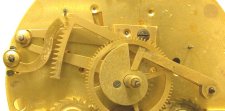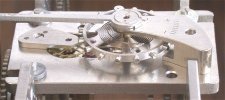To determine the extent to which the platform was damaged, I removed the balance wheel and removed some rust between the pallet bridge and the balance wheel to create some clearance. Despite the rust on the hairspring, the clock ran, albeit poorly. Since English Levers often perform poorly, it was time for an experiment. I removed the platform and placed another platform in its place. I am familiar with the Russian platform with the Swiss Lever escapement, having used one on a French carriage clock. Here is a photo of a Russian platform.
This is when the investigation became interesting: the amplitude of oscillation of the balance wheels on both platforms was more or less equal. Since the Russian platform was a good performer, this suggested that there was nothing mechanically wrong with the English Lever platform on my Japy clock. The problem was therefore in a weak mainspring, if there were no rough pivots or other problems in the gear train. Upon taking the mechanism apart, it became clear that the mainsprings in the time and strike trains were the same, and they both appeared to be original. They were 0.009" thick. I replaced the time mainspring with a new one that was 0.0011" thick and, based on my estimate, almost twice as powerful as the original.
This clock had virtually no visible wear. At this point it became clear that the reason why there were so many replacement bushings. The clock had never worked properly with the English Lever platform because the mainspring it had was for a French or Swiss Cylinder escapement, which required much less power. When the mechanism was exported to the UK, the time mainspring needed to be upgraded for use with an English Lever escapement.
The clock ran well with the new mainspring, which, when fully wound, provided enough power to give the balance wheel a full 360º turn (that is, half a turn each way from centre). Upon a test run, however, the clock lost a lot of time. I expect that the hairspring was weakened by the formation of rust on its surface.
The regulator could be advanced only so far before the hairspring became distorted and before the rusted condition of the regulator might result in it breaking completely. I moved it far to the left (fast) position, and the clock was still losing more than three minutes per day. When I moved it further, the regulator broke, so my English Lever became free sprung. The question was whether to repair the existing platform or to replace it with a new one.
Using a Timetrax timing machine, I got a reading of 17732 without the regulator. What I wanted was 18000 beats per hour. I removed one screw from the balance wheel and took a reading. Removing only one screw caused the balance wheel to become out of poise (that is, it had an uneven weight distribution). The poise problem would not be a serious issue in this case because the balance wheel would rotate only on a horizontal plane, and would therefore not be affected by gravity in its movement. (It would be a serious problem in watches, wherein the balance wheels rotate in all positions.) The reading I got with one screw removed was still slow, so I removed another screw from the other side of the balance wheel, this time expecting the clock to run too fast. With two screws removed, I got a reading of 18005. Surprisingly, it would not be necessary to undercut any of the screws to remove more weight, nor would I need to add timing washers, since this was probably close enough: a reading of 18013 means one minute fast per day.
Instead of gaining time, the clock lost about fifty seconds per day in the first three days, followed by a loss of about twenty seconds per day in the second three days, and no loss on the seventh day. Spring-driven clocks tend to run faster in the beginning of the week and slower towards the end of the week, whereas this clock ran faster towards the end of the week. Greater accuracy was achievable, but would have been unwarranted in this case, given the uncompensated nature of the balance wheel in this clock, the rust on the hairspring, the asymmetrical design of the English Lever, and the variation in mainspring torque over seven days. Since the balance wheel in this clock was not compensated for temperature, the timekeeping would vary considerably between winter and summer. The best part was being able to repair the clock while keeping the original parts, preserving the history of the clock. The repair of antiques should be about preserving their history.
French Clock Photos
Clock Repair Main Page
Escapements in Motion
Links Page






